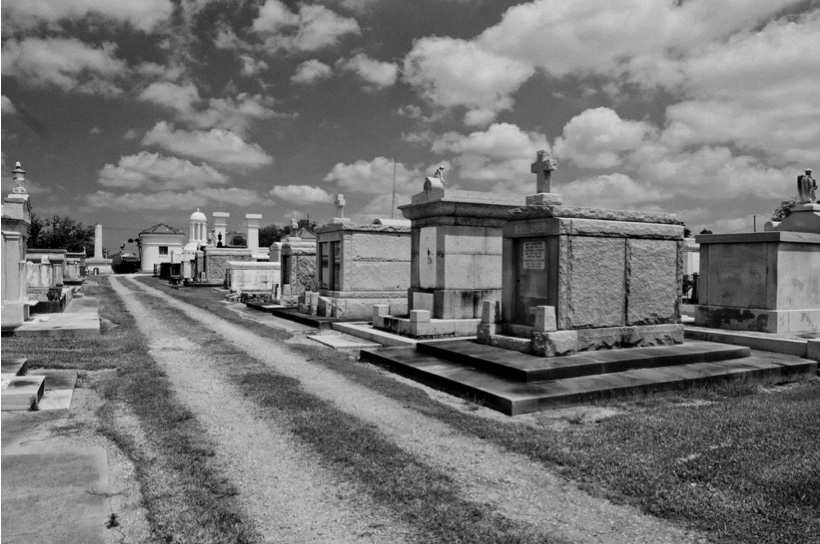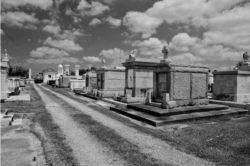Cypress Grove Cemetery
The Cypress Grove Cemetery in New Orleans has a monumental entrance gate suggesting a triumphal passage from one world to the next.

Courtesy of Alysha Jordan
Cypress Grove Cemetery. Jordan, Alysha (Photographer)
Established by the Firemen’s Charitable & Benevolent Association, Cypress Grove Cemetery is located on a ridge four miles from the center of New Orleans. After philanthropist Stephen Henderson bequeathed property to the association, the organization sold the property and used the proceeds to buy the cemetery site at what was then the end of Canal Street. Although graves here could be sunk six feet without reaching water, the preference for above-ground tombs persisted. The cemetery, laid out with a 28-foot-wide central avenue flanked by narrower aisles, has a monumental entrance gate in the Egyptian Revival style, suggesting a triumphal passage from one world to the next. The stuccoed brick gate was originally topped by a lintel, making it similar in appearance to the Egyptian Revival gate at Mount Auburn Cemetery (1831) in Cambridge, Massachusetts. Civil engineer Frederick Wilkinson, who had been assigned to New Orleans in 1831 from the northeastern United States while serving in the U.S. Army, so it is likely that he was familiar with Mount Auburn and the new fashion for Egyptian Revival From 1838 to 1840 Wilkinson served as Deputy Surveyor-General of Louisiana, and in 1840 he was appointed Surveyor of the City of New Orleans, the same year his scheme for Cypress Grove was laid out. Wilkinson died in 1841 at the age of twenty-nine.
Two pavilions flank the gate, one a porter’s lodge and the other the so-called dead house. Built of brick, the pavilions and the gate were plastered and painted to imitate Egyptian marble. On a practical level, gates and gatehouses were essential for cemetery security in that era, because grave robbery was a problem until the medical profession was able to obtain cadavers legally. One of the cemetery’s finest tombs, adapted from a design in Père Lachaise Cemetery in Paris, is J. N. B. de Pouilly’s monument for fireman Irad Ferry (1841), composed of a large broken column, symbolizing the extinction of life, rising from a sarcophagus-shaped marble tomb.
Another notable monument within Cypress Grove Cemetery is that of the Soon On Tong Association, built in 1904 for Chinese immigrants and their descendants. A small fireplace was built within the walk-in tomb for visitors to burn prayer notes for their deceased relatives. The tomb is one of the last vestiges of the Cantonese-speaking Chinese community that was centered on Tulane Avenue until the late 1930s.
Across the road, at 5242 Canal Boulevard, is Greenwood Cemetery, established in 1852 by the Firemen’s Charitable Association, which has a cluster of magnificent tombs near its entrance. The tomb for the Benevolent Protective Order of Elks, Lodge No. 30, is a marble chamber covered by a grassy mound and surmounted by a bronze elk. The tomb is lopsided; its pedimented granite entrance with Doric columns tilts perilously forward, sinking into the soft ground because the engineer failed to build a pile foundation.
Adapted from Karen Kingsley’s Buildings of Louisiana, part of the Buildings of the United States series commissioned by the Society of Architectural Historians (www.sah.org) and published by Oxford University Press.
